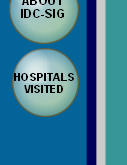.gif)
.gif)

|
Imaging in Developing Countries |
|
Special Interest Group |











|
RADIOLOGY IN MALAWI – AN OVERVIEW |
|
COWLES ANDREW CHILINGULO |
|
BLANTYRE MALARIA PROJECT – MRI CENTRE |
|
INTRODUCTION |
|
Malawi is located between Mozambique, Zambia and Tanzania in East Africa. Formerly British ruled, it has a population of 13 million (1999 census) with 87% of these in rural areas. Economically, Malawi is a third world country that is among the bottom 10 on the UNDP per capita scale. Like most third world countries, Malaria, HIV, Respiratory and Diarrhoeal diseases form the bulk of the disease burden, making preventive medicine the health priority at national level. This has been a contributory factor to the slow development of Radiology in Malawi |
|
The country has three regions (South, Centre and North) and in within these regions are 27 districts each with a government district hospital. Health care services are provided by the government, missionaries and the private sector at three levels. Primary level (rural hospitals or health centres), secondary level (district hospitals) and tertiary level (referral or central hospitals). There are four referral (central) hospitals, 24 district hospitals each with an x-ray department run by the government. Apart from these, there are two referral private hospitals and 20 mission hospitals each of which has an x-ray department. |
|
RADIOGRAPHY TRAINING AND PERSONNEL |
|
Before 1980 there was no school for Medicine or Radiography in Malawi. There were three Radiographers trained in the United Kingdom who worked in the three major hospitals of Blantyre, Zomba and Lilongwe. This means that radiography in the majority of the hospitals was carried out by untrained personnel. |
|
In 1981 Radiography training started at the Malawi College of Health Sciences (MCHS) (formerly Lilongwe School for Health Sciences) with the support of World Health Organization and the French Government. Initially the training was at certificate level but was later upgraded to diploma level in 1991. Apart from this other radiographers were trained in the United Kingdom, Zambia, Kenya and South Africa. To date all radiographers are trained at MCHS at diploma level. To obtain a degree one has to go to South Africa and enrol at any of the universities there. There are 65 radiographers at present in Malawi and of these 6 have got Bachelors’s degrees obtained in South Africa. |
|
The training at MCHS is solely concentrating on general radiography only. Ultrasound, CT scanning and MRI are not covered as part of the training. |
|
Currently Malawi has one radiologist who runs a private practice but consults at the government’s Queen Elizabeth Central Hospital in Blantyre at specified times. The Radiologist therefore serves the whole Malawi population of 13 million people. Interpretation of x-ray images in the rest of the other hospitals is therefore done by clinicians/physicians. Those that can afford do send their images to the radiologist for assistance do so at some cost. The challenges in the delivery of quality radiological services in Malawi is therefore training of personnel, especially |
|
a) Radiologists |
|
b) Ultrasonographers |
|
c) CT and MRI Radiographers |
|
EQUIPMENT |
|
Over the last 10 years the country has experienced tremendous growth in hospital infrastructure. Almost all district hospitals have been either upgraded or newly constructed altogether such that even radiography departments have been equipped with new machines. Of particular mention is the fact that there has been a lot of ultrasound machines made available in almost all hospitals. Of all the major hospitals in the country only Mwaiwathu Private and Mzuzu central Hospitals have fluoroscopy equipment. The rest of the other hospitals just have general x-ray equipment. |
|
Queen Elizabeth and Kamuzu Central Hospitals had Tomography Xray units (fig 1) which was very useful in spine and Urinary tract examinations. |
|
Fig 1: Old tomography unit at Queens. This was very useful in imaging urinary tract, spinal and mediastinal lesions. |
|
The role of these tomography units today has been surpassed by Computer assisted cross sectional imaging. |
-059.jpg)
.gif)